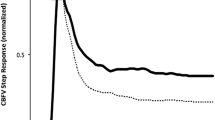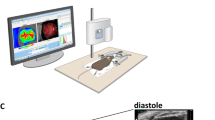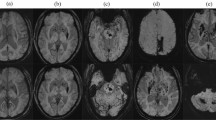Abstract
We systematically reviewed case reports of posterior reversible encephalopathy syndrome (PRES), and investigated the characteristics of PRES in pregnant Japanese women and the clinical relevance of reversible cerebral vasoconstriction syndrome (RCVS) in pregnant women with PRES. Articles were collected using the PubMed/Medline and Ichushi-Web databases. This review was ultimately conducted on 121 articles (162 patients). The clinical characteristics of PRES, individual sites of PRES lesions, edema types, and clinical characteristics of RCVS in PRES cases were examined. The most common individual site of PRES lesion was the occipital lobe (83.3%), followed by the basal ganglia, parietal lobe, frontal lobe, brain stem, cerebellum, temporal lobe, thalamus, and splenium corpus callosum (47.5, 42.6, 24.7, 16.1, 9.3, 5.6, 4.3, and 0.0%, respectively). Edema types in 79 cases with PRES were mainly the vasogenic edema type (91.1%), with very few cases of the cytotoxic edema type (3.8%) and mixed type (5.1%). Among 25 PRES cases with RCVS, RCVS was not strongly suspected in 17 (68.0%) before magnetic resonance angiography. RCVS was observed at the same time as PRES in 13 cases (approximately 50%), and between days 1 and 14 after the onset of PRES in the other 12. These results suggest that the basal ganglia is a frequent site of PRES lesions in pregnant women. RCVS may occur at or after the onset of PRES, even if there are no symptoms to suggest RCVS.

This is a preview of subscription content, access via your institution
Access options
Subscribe to this journal
Receive 12 print issues and online access
$259.00 per year
only $21.58 per issue
Buy this article
- Purchase on Springer Link
- Instant access to full article PDF
Prices may be subject to local taxes which are calculated during checkout


Similar content being viewed by others
References
Hinchey J, Chaves C, Appignani B, Breen J, Pao L, Wang A, et al. Ai reversible posterior leukoencephalopathy syndrome. N Eng J Med. 1996;334:494–500.
Fugate JE, Rabinstein AA. Posterior reversible encephalopathy syndrome: clinical and radiological manifestations, pathophysiology, and outstanding questions. Lancet Neurol. 2015;14:914–25.
Lamy C, Oppenheim C, Meder JF, Mas JL. Neuroimaging in posterior reversible encephalopathy syndrome. J Neuroimaging. 2004;14:89–96.
Calabrese LH, Dodick DW, Schwedt TJ, Singhal AB. Narrative review: reversible cerebral vasoconstriction syndromes. Ann Intern Med. 2007;146:34–44.
Miller TR, Shivashankar R, Mossa-Basha M, Gandhi D. Reversible verebral vasoconstriction syndrome, Part 1: epidemiology, pathogenesis, and clinical course. Am J Neuroradiol. 2015;36:1392–99.
Ductos A. Reversible cerebral vasoconstriction syndrome. Lancet Neurol. 2012;11:906–17.
Dong XY, Bai CB, Nao JF. Clinical and radiological features of posterior reversible encephalopathy syndrome in patients with pre-eclampsia and eclampsia. Clin Radio. 2017;72:887–95.
An P, Zhang J, Li Y, Duan P, Hu Y, Li X, et al. Clinical and imaging data-based model for predicting reversible posterior leukoencephalopathy syndrome (RPLS) in pregnant women with severe preeclampsia or eclampsia and analysis of perinatal outcomes. Int J Clin Pract. 2022;2022:6990974. https://doi.org/10.1155/2022/6990974.
Verma AK, Garg RK, Pradeep Y, Malhotra HS, Rizvi I, Kumar N, et al. Posterior encephalopathy syndrome in women with eclampsia: predictors and outcome. Pregnancy Hypertens. 2017;10:74–82.
Basavarajappa DH, Saha PK, Bagga R, Khandelwal N, Modi M. Neuroradiological perspectives of severe preeclampsia and eclampsia spectrum-correlation from posterior reversible encephalopathy syndrome. Pregnancy Hypertens. 2020;20:119–23.
Brewer J, Owens MY, Wallance K, Reeves AA, Morris R, Khan M, et al. Posterior reversible encephalopathy syndrome in 46 of 47 patients with eclampsia. Am J Obstet Gynecol. 2013;208:468.e1-6
Knight M. UKOSS. Eclampsia in the United Kingdom 2005. BJOG. 2007;114:1072–8.
Miguil M, Chekairi A. Eclampsia. Study of 342 cases. Hypertens Pregnancy. 2008;27:103–11.
Schaap TP, Knight M, Zwart JJ, Kurinczuk JJ, Brocklehurst P, van Roosmalen J, et al. Eclampsia, a comparison within the international network of obstetric survey systems. BJOG. 2014;121:1521–8.
Ohno Y. Ninsanpu no no shukketsu he no taio wo no shinkei geka to kyodo suru [Collaborative management of stroke during pregnancy with neurosurgeon]. Acta Obstet Gynaecol Japonica. 2018;70:1165–9.
Dong X, Nao J. Influential factors and clinical significance of an atypical presentation of posterior reversible encephalopathy syndrome in patients with eclampsia. Neurol Sci. 2019;40:377–84.
Litman TG, Bohner G, Heuschmann PU, Scheel M, Endres M, Siebert E. Clinical and radiological differences in posterior reversible encephalopathy syndrome between patients with preeclampsia-eclampsia and other predisposing diseases. Eur J Neurol. 2012;19:935–43.
Chen Z, Zhang G, Lerner A, Wang AH, Gao B, Liu J. Risk factors for poor outcome in posterior reversible encephalopathy syndrome: systematic review and meta-analysis. Quant Imaging Med Surg. 2018;8:421–32.
Magid-Bernestein J, Omran SS, Parikh NS, Merkler AE, Navi B, Kamel H. reversible cerebral vasoconstriction syndrome. Neurology. 2021;97:e248–53.
Pacheco K, Ortiz JF, Parwani J, Cruz C, Yépez M, Buj M, et al. Reversible cerebral vasoconstriction in thepostpartum period: a systematic review and meta-analysis. Neurol Int. 2022;14:488–96.
Bartynski WS, Boardman JF. Distinct imaging patterns and lesion distribution in posterior reversible encephalopathy syndrome. Am J Neuroradiol. 2007;28:1320–7.
Petty GW, Brown RD Jr, Whisnant JP, Sicks JD, O’Fallon WM, Wiebers DO. Ischemic stroke subtypes: ai population-based study of incidence and risk factors. Stroke. 1999;30:2513–6.
Woo D, Gebel J, Miller R, Kothari R, Brott T, Khoury J, et al. Incidence rates of first-ever ischemic stroke subtypes among blacks: a population-based study. Stroke. 1999;30:2517–22.
Kubo M, Kiyohara Y, Ninomiya T, Tanizaki Y, Yonemoto K, Doi Y, et al. Decreasing incidence of lacunar vs other types of cerebral infarction in ai Japanese population. Neurology. 2006;66:1539–44.
Kubo M, Hata J, Doi Y, Tanizaki Y, Iida M, Kiyohara Y. Secular trends in the incidence of and risk factors for ischemic stroke and its subtypes in Japanese population. Circulation. 2008;118:2673–8.
Argaw AT, Asp L, Zhang J, Navrazhina K, Pham T, Mariani JN, et al. Astrocyte-derived VEGF-A drives blood-brain barrier disruption in CNS inflammatory disease. J Clin Invest. 2012;22:2454–68.
Chen Z, Shen GQ, Lerner A, Gao B. Immune system activation in the pathogenesis reversible encephalopathy syndrome. Brain Res Bull. 2017;131:93–9.
Schreurs MP, Houston EM, May V, Cipolla MJ. The adaptation of the blood-brain barrier to vascular endothelial growth factor and placental growth factor during pregnancy. FASEB J. 2012;26:355–62.
Hernández-Pacheco JA, Rosales-Zamudio CI, Borboa-Olivares H, Espejel-Núñez A, Parra-Hernández S, Estrada-Gutiérrez G, et al. The sFlt-1/PlGF ratio as a triage tool to identify superimposed preeclampsia in women with chronic hypertension in emergency rooms. Pregnancy Hypertens. 2020;21:38–42.
Covarrubias DJ, Luetmer PH, Campeau NG. Posterior reversible encephalopathy syndrome: prognostic utility of quantitative diffusion-weighted MR images. AJNR. 2002;23:1038–48.
Noda K, Fukae J, Fujishima K, Mori K, Urabe T, Hattori N, et al. Reversible cerebral vasoconstriction syndrome presenting as subarachnoid hemorrhage, reversible posterior leukoencephalopathy, and cerebral infarction. Intern Med. 2011;50:1227–33.
Miller TR, Shivashankar R, Mossa-Basha M, Gandhi D. Reversible cerebral vasoconstriction syndrome, part 1: epidemiology, pathogenesis, and clinical course. Am J Neuroradiol. 2015;36:1392–9.
Singhal AB. Postpartum angiopathy with reversible posterior leukoencephalopathy. Arch Neurol. 2004;61:411–6.
Fugate J, Claassen DO, Cloft HJ, Kallmes DF, Kozak OS, Rabinstein AA. Posterior reversible encephalopathy syndrome: associated clinical and radiologic findings. Mayo Clin Proc. 2010;85:427–32.
Pande AR, Ando K, Ishikura R, Nagami Y, Takada Y, Wada A, et al. Clinicoradiological factors influencing the reversibility of posterior reversible encephalopathy syndrome: a multicenter study. Radiat Med. 2006;24:659–68.
Fang XB, Chen DJ, He F, Chen J, Zhou Z, Liang YL, et al. Predictors of oedema type in reversible posterior leukoencephalopathy syndrome with preeclampsia or eclampsia. Pregnancy Hypertens. 2018;11:71–6.
Mayama M, Uno K, Tano S, Yoshihara M, Ukai M, Kishigami Y, et al. Incidence of posterior reversible encephalopathy syndrome in eclamptic and patients with preeclampsia with neurologic symptoms. Am J Obstet Gynecol. 2016;215:239.e1-5
Acknowledgements
The authors received advice from Dr. Teppei Matsubara, a neurosurgeon, during the preparation of this article.
Author information
Authors and Affiliations
Corresponding author
Ethics declarations
Conflict of interest
The authors declare no competing interests.
Additional information
Publisher’s note Springer Nature remains neutral with regard to jurisdictional claims in published maps and institutional affiliations.
Supplementary information
Rights and permissions
Springer Nature or its licensor (e.g. a society or other partner) holds exclusive rights to this article under a publishing agreement with the author(s) or other rightsholder(s); author self-archiving of the accepted manuscript version of this article is solely governed by the terms of such publishing agreement and applicable law.
About this article
Cite this article
Suzuki, H., Ohkuchi, A., Horie, K. et al. Clinical relevance of reversible cerebral vasoconstriction syndrome in pregnant women with posterior reversible encephalopathy syndrome: review of case reports in Japan. Hypertens Res 47, 1288–1297 (2024). https://doi.org/10.1038/s41440-024-01619-5
Received:
Revised:
Accepted:
Published:
Issue Date:
DOI: https://doi.org/10.1038/s41440-024-01619-5



